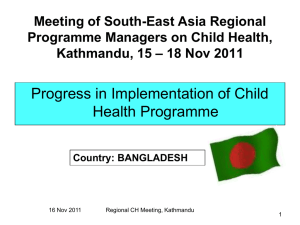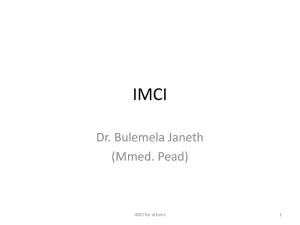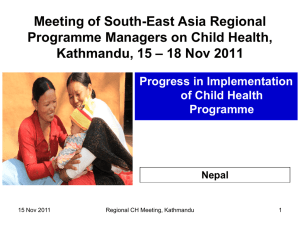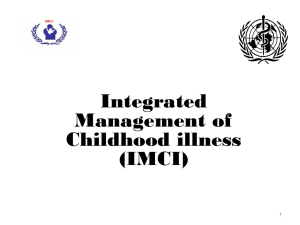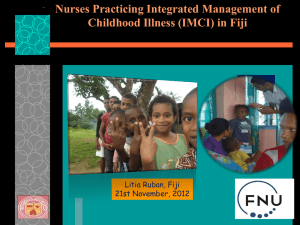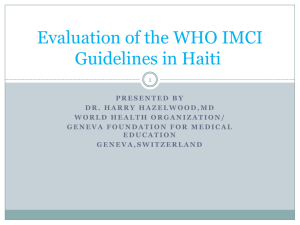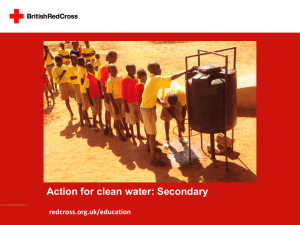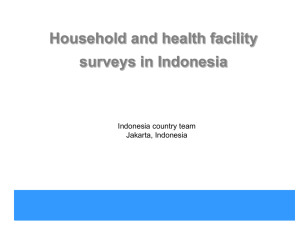С.Д.АСФЕНДИЯРОВ АТЫНДАҒЫ ҚАЗАҚ ҰЛТТЫҚ МЕДИЦИНА
advertisement
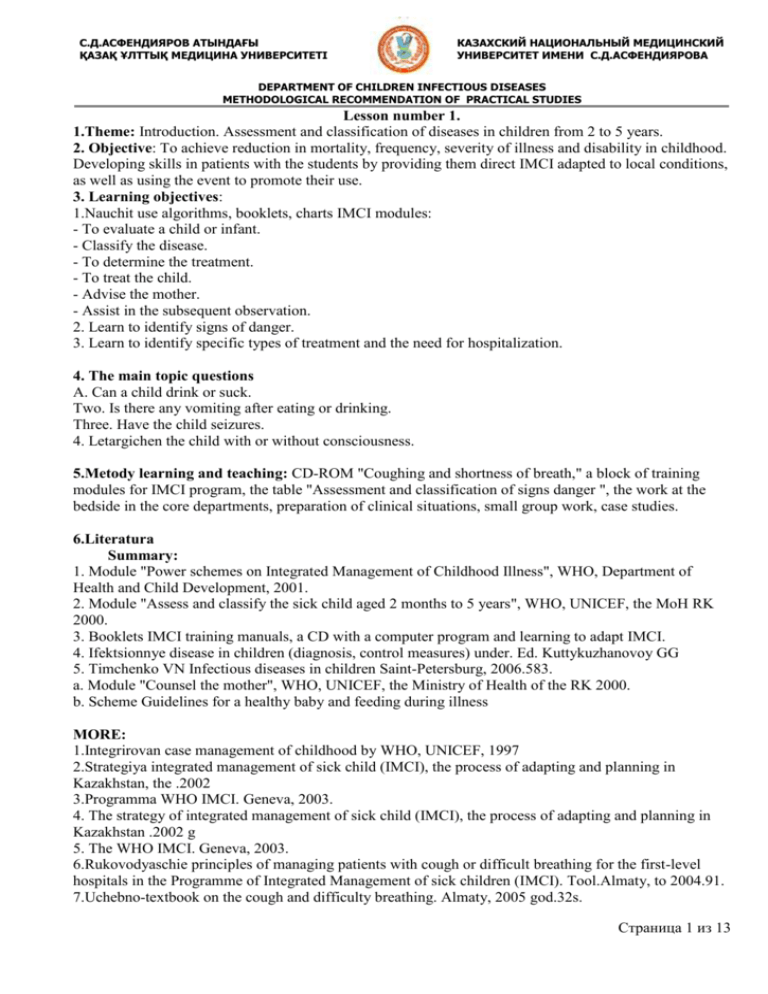
С.Д.АСФЕНДИЯРОВ АТЫНДАҒЫ ҚАЗАҚ ҰЛТТЫҚ МЕДИЦИНА УНИВЕРСИТЕТІ КАЗАХСКИЙ НАЦИОНАЛЬНЫЙ МЕДИЦИНСКИЙ УНИВЕРСИТЕТ ИМЕНИ С.Д.АСФЕНДИЯРОВА DEPARTMENT OF CHILDREN INFECTIOUS DISEASES METHODOLOGICAL RECOMMENDATION OF PRACTICAL STUDIES Lesson number 1. 1.Theme: Introduction. Assessment and classification of diseases in children from 2 to 5 years. 2. Objective: To achieve reduction in mortality, frequency, severity of illness and disability in childhood. Developing skills in patients with the students by providing them direct IMCI adapted to local conditions, as well as using the event to promote their use. 3. Learning objectives: 1.Nauchit use algorithms, booklets, charts IMCI modules: - To evaluate a child or infant. - Classify the disease. - To determine the treatment. - To treat the child. - Advise the mother. - Assist in the subsequent observation. 2. Learn to identify signs of danger. 3. Learn to identify specific types of treatment and the need for hospitalization. 4. The main topic questions A. Can a child drink or suck. Two. Is there any vomiting after eating or drinking. Three. Have the child seizures. 4. Letargichen the child with or without consciousness. 5.Metody learning and teaching: CD-ROM "Coughing and shortness of breath," a block of training modules for IMCI program, the table "Assessment and classification of signs danger ", the work at the bedside in the core departments, preparation of clinical situations, small group work, case studies. 6.Literatura Summary: 1. Module "Power schemes on Integrated Management of Childhood Illness", WHO, Department of Health and Child Development, 2001. 2. Module "Assess and classify the sick child aged 2 months to 5 years", WHO, UNICEF, the MoH RK 2000. 3. Booklets IMCI training manuals, a CD with a computer program and learning to adapt IMCI. 4. Ifektsionnye disease in children (diagnosis, control measures) under. Ed. Kuttykuzhanovoy GG 5. Timchenko VN Infectious diseases in children Saint-Petersburg, 2006.583. a. Module "Counsel the mother", WHO, UNICEF, the Ministry of Health of the RK 2000. b. Scheme Guidelines for a healthy baby and feeding during illness MORE: 1.Integrirovan case management of childhood by WHO, UNICEF, 1997 2.Strategiya integrated management of sick child (IMCI), the process of adapting and planning in Kazakhstan, the .2002 3.Programma WHO IMCI. Geneva, 2003. 4. The strategy of integrated management of sick child (IMCI), the process of adapting and planning in Kazakhstan .2002 g 5. The WHO IMCI. Geneva, 2003. 6.Rukovodyaschie principles of managing patients with cough or difficult breathing for the first-level hospitals in the Programme of Integrated Management of sick children (IMCI). Tool.Almaty, to 2004.91. 7.Uchebno-textbook on the cough and difficulty breathing. Almaty, 2005 god.32s. Страница 1 из 13 С.Д.АСФЕНДИЯРОВ АТЫНДАҒЫ ҚАЗАҚ ҰЛТТЫҚ МЕДИЦИНА УНИВЕРСИТЕТІ КАЗАХСКИЙ НАЦИОНАЛЬНЫЙ МЕДИЦИНСКИЙ УНИВЕРСИТЕТ ИМЕНИ С.Д.АСФЕНДИЯРОВА DEPARTMENT OF CHILDREN INFECTIOUS DISEASES METHODOLOGICAL RECOMMENDATION OF PRACTICAL STUDIES 8. Module "Treat the child", WHO, UNICEF, the MoH RK 2000. 7. Control. Lesson number 2 1.Tema: Identification of common danger signs. 2. Objective: To achieve reduction in mortality, frequency, severity of illness and disability in childhood. Developing skills in patients with the students by providing them direct IMCI adapted to local conditions, as well as using the event to promote their use. 3. Learning objectives: 1.Learn to identify a presence of danger signs. 2.Learn to identify specific types of treatment and the need for hospitalization. 4. The main topic questions • Can the child drink or suck. • Is there any vomiting after eating or drinking. • Have the child's seizures. • Does the child Letargichen or without consciousness. 5.Metody learning and teaching: a block of training modules for IMCI program, the table "Assessment and classification of signs of danger," the work at the bedside in the relevant departments, preparation of clinical situations, small group work, case studies. 6.Literatura 1. Module "Evaluate and classify the sick child aged 2 months to 5 years", WHO, UNICEF, the MoH RK 2000. 2. The disc with the computer program and learning to adapt IMCI. 3. Module "Counsel the mother", WHO, UNICEF, the Ministry of Health of the RK 2000. 4.Shema Recommendations for a healthy baby and feeding during illness MORE: 1.Uchebno-textbook on the cough and difficulty breathing. Almaty, 2005 god.32s. 2. Module "Treat the child", WHO, UNICEF, the MoH RK 2000. 7. Control. Lesson 3 1. Lesson 3: Assessment and classification of cough IMCI program for primary level health care 2. Objective: to develop and strengthen skills of patients with cough using IMCI guidelines by the tables, algorithms, and counseling skills of parents on the sick child coughs when you need to return immediately to a medical facility 3.Learning objectives: • To teach students to assess and classify sick children with cough in modulus of IMCI; • Build knowledge of the students to assess sick children with cough in modulus of IMCI; • Build knowledge of the students classified as sick children with cough in modulus of IMCI; • Create the ability to examination of the patient to identify cough modulo IMCI; • Create the ability to determine the severity of the condition, the degree of damage of the respiratory system of patients with cough of children in absolute value of IMCI; • Create a student's ability to advise the mother of a child with a cough and work with the sick child, but also teach follow-up care and the need to immediately return to the Medical Institutions; 4.Osnovnye topic questions: 1. Definition and classification of cough IMCI program; 2. Stages of evaluation of the child with a cough: • Survey - how long the child cough; • Examination and identification signs - shortness of breath; Страница 2 из 13 С.Д.АСФЕНДИЯРОВ АТЫНДАҒЫ ҚАЗАҚ ҰЛТТЫҚ МЕДИЦИНА УНИВЕРСИТЕТІ КАЗАХСКИЙ НАЦИОНАЛЬНЫЙ МЕДИЦИНСКИЙ УНИВЕРСИТЕТ ИМЕНИ С.Д.АСФЕНДИЯРОВА DEPARTMENT OF CHILDREN INFECTIOUS DISEASES METHODOLOGICAL RECOMMENDATION OF PRACTICAL STUDIES - Retraction of the chest; - Stridor at rest; - Wheeze 3. Education criteria for the mother when to return immediately; 4. Making the data into a form for recording; 5. Methods of teaching and learning: CD-ROM "Coughing and shortness of breath," a block of training modules for IMCI program, the table "Assessment and classification of cough and shortness of breath," the work at the bedside in the relevant departments. 6. References: 1. Module "Evaluate and classify the sick child aged 2 months to 5 years", WHO, UNICEF, the MoH RK 2000. 2. The disc with the computer program and learning to adapt IMCI. 3. Module "Counsel the mother", WHO, UNICEF, the Ministry of Health of the RK 2000. 4.Shema Recommendations for a healthy baby and feeding during illness MORE: 1.Uchebno-textbook on the cough and difficulty breathing. Almaty, 2005 god.32s. 2. Module "Treat the child", WHO, UNICEF, the MoH RK 2000. 7. Control: Lesson number 4 1.Theme: Assessment and classification of wheeze IMCI program for primary level health care 2. Objective: to develop and strengthen skills of patients with shortness of breath with the IMCI guidelines by the tables, algorithms, and counseling skills of parents sick child on shortness of breath when you need to return immediately to a medical facility 3. Learning objectives: • To teach students to assess and classify sick children with breathing difficulties modulo IMCI; • Build knowledge of the students to assess sick children with breathing difficulties in modulus of IMCI; • Build knowledge of the students classified as sick children with breathing difficulties in modulus of IMCI; • Create the ability to examination of the patient to identify cough and shortness of breath modulo IMCI; • Create the ability to determine the severity of the condition, the degree of damage of respiratory ill children with breathing difficulties in modulus of IMCI; • Create a student's ability to advise the mother of a child with breathing difficulties and work with the sick child, but also teach follow-up care and the need to immediately return to the Medical Institutions; 4. Key questions the theme: 1.Opredelenie and classification of wheezing in the IMCI program; 1. Stages of evaluation of the child with difficulty breathing: • Survey - how long the child shortness of breath; • Examination and identification signs - shortness of breath; - Retraction of the chest; - Stridor at rest; - Wheeze 3. Education criteria for the mother when to return immediately; 4. Making the data into a form for recording; 5. Methods of teaching and learning: CD-ROM "Coughing and shortness of breath," a block of training modules for IMCI program, the table "Assessment and classification of cough and shortness of breath," the work at the bedside in the relevant departments. Страница 3 из 13 С.Д.АСФЕНДИЯРОВ АТЫНДАҒЫ ҚАЗАҚ ҰЛТТЫҚ МЕДИЦИНА УНИВЕРСИТЕТІ КАЗАХСКИЙ НАЦИОНАЛЬНЫЙ МЕДИЦИНСКИЙ УНИВЕРСИТЕТ ИМЕНИ С.Д.АСФЕНДИЯРОВА DEPARTMENT OF CHILDREN INFECTIOUS DISEASES METHODOLOGICAL RECOMMENDATION OF PRACTICAL STUDIES 6. References: 1. Module "Evaluate and classify the sick child aged 2 months to 5 years", WHO, UNICEF, the MoH RK 2000. 2. The disc with the computer program and learning to adapt IMCI. 3. Module "Counsel the mother", WHO, UNICEF, the Ministry of Health of the RK 2000. 4.Shema Recommendations for a healthy baby and feeding during illness MORE: 1.Uchebno-textbook on the cough and difficulty breathing. Almaty, 2005 god.32s. 2. Module "Treat the child", WHO, UNICEF, the MoH RK 2000. 7. Control: Lesson number 5 1 Topic: Treatment of children with cough and shortness of breath 2. Purpose: To develop and strengthen skills for the treatment of a child with difficulty breathing with the help of IMCI guidelines by the tables, algorithms, and counseling skills of parents sick child on shortness of breath when you need to return immediately to a medical facility 3. Learning objectives: • To teach students to assess and classify sick children with breathing difficulties modulo IMCI; • Build knowledge of the students to assess sick children with breathing difficulties in modulus of IMCI; • Build knowledge of the students classified as sick children with breathing difficulties modulo IMCI; Forming examination of the patient the ability to detect cough and shortness of breath modulo IMCI; • Create the ability to determine the severity of the condition, the degree of damage of respiratory ill children with breathing difficulties in modulus of IMCI; • Create a student's ability to advise the mother of a child with breathing difficulties and work with the sick child, but also teach follow-up care and the need to immediately return to the Medical Institutions; 4. Key questions the theme: 1.Etapy assess a child with difficulty breathing: • Survey - how long the child coughing / shortness of breath • Examination and identification signs - shortness of breath; - Retraction of the chest; - Stridor at rest; - Wheeze 2 Training methods use high-speed aerosol bronchodilator 3. Learn three criteria mother when to return immediately; 4. Making the data into a form for recording; 5. Methods of teaching and learning: CD-ROM "Coughing and shortness of breath," a block of training modules for IMCI program, the table "Assessment and classification of cough and shortness of breath," the work at the bedside in the relevant departments. 6. References: 1. Module "Evaluate and classify the sick child aged 2 months to 5 years", WHO, UNICEF, the MoH RK 2000. 2. The disc with the computer program and learning to adapt IMCI. 3. Module "Counsel the mother", WHO, UNICEF, the Ministry of Health of the RK 2000. 4.Shema Recommendations for a healthy baby and feeding during illness MORE: 1.Uchebno-textbook on the cough and difficulty breathing. Almaty, 2005 god.32s. 2. Module "Treat the child", WHO, UNICEF, the MoH RK 2000. 7. Control: Страница 4 из 13 С.Д.АСФЕНДИЯРОВ АТЫНДАҒЫ ҚАЗАҚ ҰЛТТЫҚ МЕДИЦИНА УНИВЕРСИТЕТІ КАЗАХСКИЙ НАЦИОНАЛЬНЫЙ МЕДИЦИНСКИЙ УНИВЕРСИТЕТ ИМЕНИ С.Д.АСФЕНДИЯРОВА DEPARTMENT OF CHILDREN INFECTIOUS DISEASES METHODOLOGICAL RECOMMENDATION OF PRACTICAL STUDIES Lesson number 6 Topic 1: Assessment and classification of diarrhea the IMCI program 2 Purpose: To develop and strengthen skills of patients with diarrhea using IMCI guidelines by the tables, algorithms, and counseling skills of parents of a sick child feeding problems and situations when you need to return immediately to a medical facility 3 Learning objectives: • To teach students to assess and classify sick children with diarrhea in modulus of IMCI; • Teach students to determine the treatment of patients with diarrhea, depending on the degree of dehydration and the type of diarrhea; • Teach the student to advise the mother on feeding a sick child with diarrhea, aftercare and the need to immediately return to the Medical Institutions; 4 Key Questions Topics: 1.Opredelenie and classification of types of diarrhea the IMCI program; 2.Etapy evaluation of the child with diarrhea: • Survey - how long the baby diarrhea; -Whether there is blood in the stool; • Examination and identification signs - letargichen or unconscious; - Restless and / or painful irritated; - Are looking for, whether sunken eyes; - Suggest that the child fluid. Not able to drink or drinking poorly? Drinks with greed, lust? - Check the rate of unfolding of skin folds on the abdomen: • cracked down very slowly (more than 2 seconds); • slow (up to 2 sec); • immediately 3.Klassifikatsiya and treatment of diarrhea in the degree of dehydration: • Severe dehydration; • Moderate dehydration; • There is no dehydration; 4.Klassifikatsiya and treatment of protracted diarrhea; 5.Klassifikatsiya and treatment of dysentery (an invasive diarrhea); 6.Obuchenie criteria mother when to return immediately; 7.Rekomendatsii on feeding the child during the acute and protracted diarrhea; 8.Oformlenie the data into a form for recording; 5 Methods of teaching and learning: CD-ROM "Evaluation of a child with diarrhea," a block of training modules for IMCI program, the table, "If a child has diarrhea," the work at the bedside in the relevant departments. 6 References: 1. Module "Evaluate and classify the sick child aged 2 months to 5 years", WHO, UNICEF, the MoH RK 2000. 2. The disc with the computer program and learning to adapt IMCI. 3. Module "Counsel the mother", WHO, UNICEF, the Ministry of Health of the RK 2000. 4.Shema Recommendations for a healthy baby and feeding during illness MORE: 1.Uchebno-textbook on the cough and difficulty breathing. Almaty, 2005 god.32s. 2. Module "Treat the child", WHO, UNICEF, the MoH RK 2000. 7 Control: Lesson number 7 Страница 5 из 13 С.Д.АСФЕНДИЯРОВ АТЫНДАҒЫ ҚАЗАҚ ҰЛТТЫҚ МЕДИЦИНА УНИВЕРСИТЕТІ КАЗАХСКИЙ НАЦИОНАЛЬНЫЙ МЕДИЦИНСКИЙ УНИВЕРСИТЕТ ИМЕНИ С.Д.АСФЕНДИЯРОВА DEPARTMENT OF CHILDREN INFECTIOUS DISEASES METHODOLOGICAL RECOMMENDATION OF PRACTICAL STUDIES 1. Subject: Definition of treatment for diarrhea the IMCI program 2. Purpose: To develop and strengthen skills of patients with diarrhea using IMCI guidelines through the tables, algorithms, and counseling skills of parents of a sick child feeding problems and situations when you need to return immediately to a medical facility 3. Learning objectives: A. To teach students to identify areas of urgent need in the hospital in modulus of IMCI; B. To teach students to identify treatment of patients with diarrhea, depending on the degree of dehydration and the type of diarrhea; C. To teach the student to advise the mother on feeding a sick child with diarrhea, aftercare and the need to go to a medical facility immediately; D. Drawing lines 4. Key questions the theme: A. Select a treatment plan for the IMCI program; Plan A - Treat diarrhea at home Plan B - Moderate Treat dehydration with oral rehydration salts (ORS) Plan B - Treat Severe Dehydration Quickly B. Treatment of protracted diarrhea C. Treatment of dysentery 5. Methods of teaching and learning: CD-ROM "Evaluation of a child with diarrhea," a block of training modules for IMCI program, the table, "If a child has diarrhea," the work at the bedside in the relevant departments. 6. References: 1. Module "Evaluate and classify the sick child aged 2 months to 5 years", WHO, UNICEF, the MoH RK 2000. 2. The disc with the computer program and learning to adapt IMCI. 3. Module "Counsel the mother", WHO, UNICEF, the Ministry of Health of the RK 2000. 4.Shema Recommendations for a healthy baby and feeding during illness MORE: 1.Uchebno-textbook on the cough and difficulty breathing. Almaty, 2005 god.32s. 2. Module "Treat the child", WHO, UNICEF, the MoH RK 2000. 7. Control: (20 tests for the source control, 10 situational problems). Lesson number 8. 1. Topic: Assessment and Classification of resist diarrhea, the definition of IMCI treatment program for primary level health care 2. Purpose: To develop and strengthen skills of patients with resist diarrhea using IMCI guidelines through the tables, algorithms, and counseling skills of parents of a sick child feeding problems and situations when you need to return immediately to a medical facility 3. Learning objectives: • To teach students to assess and classify sick children with persistent diarrhea in modulus of IMCI; • Teach students to determine the treatment of patients with prolonged diarrhea, depending on the degree of dehydration; Страница 6 из 13 С.Д.АСФЕНДИЯРОВ АТЫНДАҒЫ ҚАЗАҚ ҰЛТТЫҚ МЕДИЦИНА УНИВЕРСИТЕТІ КАЗАХСКИЙ НАЦИОНАЛЬНЫЙ МЕДИЦИНСКИЙ УНИВЕРСИТЕТ ИМЕНИ С.Д.АСФЕНДИЯРОВА DEPARTMENT OF CHILDREN INFECTIOUS DISEASES METHODOLOGICAL RECOMMENDATION OF PRACTICAL STUDIES • Teach the student to advise the mother on feeding a sick child with diarrhea, aftercare and the need to immediately return to the Medical Institutions; 4. Key questions the theme: 1.Opredelenie and classification of protracted diarrhea of the IMCI program; 2.Etapy evaluation of the child with diarrhea: • Survey - how long the baby diarrhea; • Examination and identification signs - letargichen or unconscious; - Restless and / or painful irritated; - Are looking for, whether sunken eyes; - Suggest that the child fluid. Not able to drink or drinking poorly? Drinks with greed, lust? - Check the rate of unfolding of skin folds on the abdomen: • cracked down very slowly (more than 2 seconds); • slow (up to 2 sec); • immediately 3.Klassifikatsiya and treatment of diarrhea in the degree of dehydration: • Severe dehydration; • Moderate dehydration; • There is no dehydration; 4. Classification and treatment of protracted diarrhea; 5. Education criteria for the mother when to return immediately; 6. Recommendations for feeding the child during prolonged diarrhea; 7. Making the data into a form for recording; 5. Methods of teaching and learning: CD-ROM "Evaluation of a child with diarrhea," a block of training modules for IMCI program, the table, "If a child has diarrhea," the work at the bedside in the relevant departments. 6. References: 1. Module "Evaluate and classify the sick child aged 2 months to 5 years", WHO, UNICEF, the MoH RK 2000. 2. The disc with the computer program and learning to adapt IMCI. 3. Module "Counsel the mother", WHO, UNICEF, the Ministry of Health of the RK 2000. 4.Shema Recommendations for a healthy baby and feeding during illness MORE: 1.Uchebno-textbook on the cough and difficulty breathing. Almaty, 2005 god.32s. 2. Module "Treat the child", WHO, UNICEF, the MoH RK 2000. 7. Control: Lesson number 9 1. Subject: Assess and classify fever IMCI program for primary level health care. 2. Purpose: To develop and consolidate knowledge of the definition of treatment for fever, sore throat, ear problems in patients using the IMCI guidelines through the tables, algorithms, and patient counseling skills of parents of the child when it is necessary to return immediately to a medical facility 3. Learning objectives: 1. Teach students to identify a sick child care program at a fever IMCI; 2. To teach students to identify with the sick child care problem with the ears; 3. To teach students to determine treatment for a sore throat; Страница 7 из 13 С.Д.АСФЕНДИЯРОВ АТЫНДАҒЫ ҚАЗАҚ ҰЛТТЫҚ МЕДИЦИНА УНИВЕРСИТЕТІ КАЗАХСКИЙ НАЦИОНАЛЬНЫЙ МЕДИЦИНСКИЙ УНИВЕРСИТЕТ ИМЕНИ С.Д.АСФЕНДИЯРОВА DEPARTMENT OF CHILDREN INFECTIOUS DISEASES METHODOLOGICAL RECOMMENDATION OF PRACTICAL STUDIES 4. Teach students to advise the mother of the child patient, aftercare and the need to return to the medical facility immediately; 4. Key questions the theme: 1. Rate fever IMCI program and prescribe treatment; 2. To assess the problems with the ears of the IMCI program and prescribe treatment; 3. Define a sore throat and prescribe treatment; 4. Education criteria for the mother when to return immediately; 5.Making the data into a form for recording; 1. Subject: Evaluation, classification of fever in IMCI program for primary level health care. 2. Purpose: To develop and consolidate naavyki management of patients with fever with the IMCI guidelines by the tables, algorithms, and counseling skills of parents with a sick child neobhadimosti to return immediately to the hospital. 3. Learning objectives: 1. To teach students to assess and classify sick children with fever in modulus of IMCI. 2. To teach students to identify a patient treated with a fever, depending on the classification. 3. To teach the student to advise the mother sick child be able to return to the hospital. 4. Key questions the theme: 1. Definition and classification of fever on the IMCI program 2. Stages of evaluation of the child with a fever: The poll has a fever in anemneze how long continued. If more than 5 days, whether it was day. whether the manifestations of measles in the last 3 hmesyatsev Inspection and sign the child in php. Baby is hot to the touch or temperature aksilyarnaya 37.5 or higher whether there is muscle rigidity zazhloyanyh is there any signs of measles (generalized rash and one of the symptoms: cough, runny nose, red eyes) if the child has measles or measles, he was sick in the last three months, examine whether ulcer Worth, purulent discharge from the eyes, blurred rogavitsy is there a problem with your ears 3. Klassification of fever. It is very difficult disease dibrilnoe Possible bacterial infection uncomplicated fever 4. Education criteria for the mother when to return immediately to the doctor. 5. Making the data into a form for recording. 5.Metody teaching and learning: Power training program models IMCI, work at the bedside of relevant departments. 6. References: 1. Module "Evaluate and classify the sick child aged 2 months to 5 years", WHO, UNICEF, the MoH RK 2000. 2. The disc with the computer program and learning to adapt IMCI. Страница 8 из 13 С.Д.АСФЕНДИЯРОВ АТЫНДАҒЫ ҚАЗАҚ ҰЛТТЫҚ МЕДИЦИНА УНИВЕРСИТЕТІ КАЗАХСКИЙ НАЦИОНАЛЬНЫЙ МЕДИЦИНСКИЙ УНИВЕРСИТЕТ ИМЕНИ С.Д.АСФЕНДИЯРОВА DEPARTMENT OF CHILDREN INFECTIOUS DISEASES METHODOLOGICAL RECOMMENDATION OF PRACTICAL STUDIES 3. Module "Counsel the mother", WHO, UNICEF, the Ministry of Health of the RK 2000. 4.Shema Recommendations for a healthy baby and feeding during illness MORE: 1.Uchebno-textbook on the cough and difficulty breathing. Almaty, 2005 god.32s. 2. Module "Treat the child", WHO, UNICEF, the MoH RK 2000. 7. Control Lesson 10. 1. Subject: Determination of the treatment of fever in IMCI program for primary level health care 2. Purpose: To develop and consolidate knowledge of the definition of treatment in patients with feverGOVERNMENTAL using IMCI guidelines through the tables, algorithms, and patient counseling skills of parents of the child when it is necessary to return immediately to a medical facility 3. Learning objectives: • Teach students to determine the treatment of a sick child with fever of IMCI program; • Teach students to advise the mother of the child patient, • Teach students to carry out follow-up • Teach students to know the criteria needed to return to the medical establishment nemed-slowly; 4.Basic topic questions: • Appoint a treatment for a patient with fever of IMCI program; • Education criteria mother when to return immediately; • Making the data into a form for recording; 5.Metody teaching and learning: Power training program models IMCI, work at the bedside of relevant departments. 6.Literatura: 1. Module "Evaluate and classify the sick child aged 2 months to 5 years", WHO, UNICEF, the MoH RK 2000. 2. The disc with the computer program and learning to adapt IMCI. 3. Module "Counsel the mother", WHO, UNICEF, the Ministry of Health of the RK 2000. 4.Shema Recommendations for a healthy baby and feeding during illness MORE: 1.Uchebno-textbook on the cough and difficulty breathing. Almaty, 2005 god.32s. 2. Module "Treat the child", WHO, UNICEF, the MoH RK 2000. 7.Control: Lesson number 11 1.Tema Measles. Assessment and classification of measles 2. Purpose: To develop and consolidate the knowledge definition of diagnosis, differential diagnosis and treatment of measles in patients with IMCI guidelines by the tables, algorithms and clinical guidelines and patient counseling skills of parents of the child when it is necessary to return immediately to a medical facility 3.Zadachi training: 1. To teach students to assess and classify sick children with measles in modulus of IMCI. 2. To teach students to identify a patient with measles treated according to the classification. 3. To teach the student to advise the mother sick child be able to return to the hospital. 4. Key questions the theme: 1. Definition and classification of fever on the IMCI program Страница 9 из 13 С.Д.АСФЕНДИЯРОВ АТЫНДАҒЫ ҚАЗАҚ ҰЛТТЫҚ МЕДИЦИНА УНИВЕРСИТЕТІ КАЗАХСКИЙ НАЦИОНАЛЬНЫЙ МЕДИЦИНСКИЙ УНИВЕРСИТЕТ ИМЕНИ С.Д.АСФЕНДИЯРОВА DEPARTMENT OF CHILDREN INFECTIOUS DISEASES METHODOLOGICAL RECOMMENDATION OF PRACTICAL STUDIES 2. Stages of evaluation of the child with measles The survey was a manifestation of measles in the last 3 mesyatsev Inspection and sign the child in php.ini hot to the touch or temperature aksilyarnaya 37.5 or higher is there a stiff neck is there any signs of measles (generalized rash and one of the symptoms: cough, runny nose, red eyes) if the child has measles or measles, he was sick in the last three months, examine whether ulcer Worth, purulent discharge from the eyes, blurred rogavitsy is there a problem with your ears 3. Klassfikatsiya and treatment of measles Severe complications of measles Measles osdlozhneniyami with mouth and eyes Measles 4. Education criteria for the mother when to return immediately to the doctor. 5. Making the data into a form for recording. 5. Methods of teaching and learning: CD-ROM "Evaluation of a child with a fever and measles," a block of training modules for IMCI program, the table, "If a child has a fever," work at a post-patient departments in the profile. 6.Literatura: 1. Module "Evaluate and classify the sick child aged 2 months to 5 years", WHO, UNICEF, the MoH RK 2000. 2. The disc with the computer program and learning to adapt IMCI. 3. Module "Counsel the mother", WHO, UNICEF, the Ministry of Health of the RK 2000. 4.Shema Recommendations for a healthy baby and feeding during illness MORE: 1.Uchebno-textbook on the cough and difficulty breathing. Almaty, 2005 god.32s. 2. Module "Treat the child", WHO, UNICEF, the MoH RK 2000. 7.Kontrol Страница 10 из 13 С.Д.АСФЕНДИЯРОВ АТЫНДАҒЫ ҚАЗАҚ ҰЛТТЫҚ МЕДИЦИНА УНИВЕРСИТЕТІ КАЗАХСКИЙ НАЦИОНАЛЬНЫЙ МЕДИЦИНСКИЙ УНИВЕРСИТЕТ ИМЕНИ С.Д.АСФЕНДИЯРОВА DEPARTMENT OF CHILDREN INFECTIOUS DISEASES METHODOLOGICAL RECOMMENDATION OF PRACTICAL STUDIES Lesson number 12. 1.Tema: Assessment and Classification of pains in the throat in the IMCI program for primary level health care 2. Purpose: To develop and strengthen skills of patients with pain in the throat with the IMCI guidelines by the tables, algorithms, and counseling skills of parents with a sick child need to return immediately to a medical facility 3. Learning objectives: 1.Nauchit students to assess and classify sick children with a sore throat in modulus of IMCI; 2.Nauchit student counseling to mothers with sick child need to return immediately to the hospital. 4.Osnovnye topic questions: 1.Opredelenie and Classification of pains in the throat in the IMCI program; 2.Etapy evaluation of the child with sick in throat: • Survey - is there a sore throat - Can a child drink • Examination and identification of at-signs -is there any white patches in throat -Is there any enlarged lymph nodes Classification and treatment of sore throat: • throat abscess • Strep throat • Nestreptokokkovy pharyngitis • Classification and treatment of throat abscess • Classification and treatment of streptococcal pharyngitis • Classification and treatment of pharyngitis nestreptokokkovogo • Education criteria mother when to return immediately to the doctor • Making the data into a form for recording; 5.Metody learning and teaching: a block of training modules for IMCI program, the table, "If a child has a sore throat," the work at the bedside in the core compartment. 6.Literatura: 1. Module "Evaluate and classify the sick child aged 2 months to 5 years", WHO, UNICEF, the MoH RK 2000. 2. The disc with the computer program and learning to adapt IMCI. 3. Module "Counsel the mother", WHO, UNICEF, the Ministry of Health of the RK 2000. 4.Shema Recommendations for a healthy baby and feeding during illness MORE: 1.Uchebno-textbook on the cough and difficulty breathing. Almaty, 2005 god.32s. 2. Module "Treat the child", WHO, UNICEF, the MoH RK 2000. 7.Kontrol: Lesson number 13 1.Tema: Defining the treatment of sore throat in the IMCI program for primary level health care 2.purpose : to develop and consolidate knowledge of determining the treatment of sore throat in patients with IMCI guidelines through the tables, algorithms, and skills consultations tirovaniya parents of the sick child, when you need to return immediately to health facilities 3.Zadachi training: • To teach students to determine treatment for a sore throat; Страница 11 из 13 С.Д.АСФЕНДИЯРОВ АТЫНДАҒЫ ҚАЗАҚ ҰЛТТЫҚ МЕДИЦИНА УНИВЕРСИТЕТІ КАЗАХСКИЙ НАЦИОНАЛЬНЫЙ МЕДИЦИНСКИЙ УНИВЕРСИТЕТ ИМЕНИ С.Д.АСФЕНДИЯРОВА DEPARTMENT OF CHILDREN INFECTIOUS DISEASES METHODOLOGICAL RECOMMENDATION OF PRACTICAL STUDIES • Teach students to advise the mother sick child in the next observation and the need to return to the medical establishment, but the immediate; 4.Osnovnye issues topics; • Classification and treatment of throat abscess • Classification and treatment of streptococcal pharyngitis • Classification and treatment of pharyngitis nestreptokokkovogo • Education criteria mother when to return immediately; • Making the data into a form for recording 5.Metody teaching and learning: Power training program models IMCI, work at the bedside of relevant departments. 6.Literatura: 1. Module "Evaluate and classify the sick child aged 2 months to 5 years", WHO, UNICEF, the MoH RK 2000. 2. The disc with the computer program and learning to adapt IMCI. 3. Module "Counsel the mother", WHO, UNICEF, the Ministry of Health of the RK 2000. 4.Shema Recommendations for a healthy baby and feeding during illness MORE: 1. Module "Treat the child", WHO, UNICEF, the MoH RK 2000. 7.Kontrol: Lesson 14. 1. Topic: Assessment and classification of pain in the ear. 2. Purpose: To form the knowledge to diagnose various problems with the ears and consolidate skills of patients with problems in the ears with the guidelines for IMCI-property by means of tables, algorithms, and counseling skills of parents and a sick child when you need to return immediately to a medical facility 3. Learning objectives: 1. The role of an integrated approach to the examination of the child; 2. How to ask her mother, "if a child has problems with his ears?" (IMCI); 3. Skill definitions form the main signs of mastoiditis in IMCI; 4. Skill definitions form the core symptoms of acute ear infection in IMCI; 5. Skill definitions form the core symptoms of chronic ear infections in IMCI; 6. Compose Skill determine the child's condition by the presence or absence of symptoms (IMCI); 7. Form a habit to classify the disease by the presence or absence of symptoms (IMCI); 4. Key questions the theme: • Program of IMCI, its relevance and purpose of the strategy; • The role of an integrated approach to the examination of the child; • How can a mother ask "whether the child has problems with his ears?" (IMCI); • Key features of mastoiditis in IMCI; • The main symptoms of acute ear infection in IMCI; • The main symptoms of chronic ear infections in IMCI; • How to classify the disease by the presence or absence of symptoms (IMCI);5. Methods of teaching and learning (small group discussion, case studies, work in pairs, presentations, case studies, etc.). 6.Literatura 1. Module "Evaluate and classify the sick child aged 2 months to 5 years", WHO, UNICEF, the MoH RK 2000. 2. The disc with the computer program and learning to adapt IMCI. 3. Module "Counsel the mother", WHO, UNICEF, the Ministry of Health of the RK 2000. 4.Shema Recommendations for a healthy baby and feeding during illness Страница 12 из 13 С.Д.АСФЕНДИЯРОВ АТЫНДАҒЫ ҚАЗАҚ ҰЛТТЫҚ МЕДИЦИНА УНИВЕРСИТЕТІ КАЗАХСКИЙ НАЦИОНАЛЬНЫЙ МЕДИЦИНСКИЙ УНИВЕРСИТЕТ ИМЕНИ С.Д.АСФЕНДИЯРОВА DEPARTMENT OF CHILDREN INFECTIOUS DISEASES METHODOLOGICAL RECOMMENDATION OF PRACTICAL STUDIES MORE: 1. Module "Treat the child", WHO, UNICEF, the MoH RK 2000.7.Kontrol (questions, tests, tasks, etc.) 7. Control (questions, tests, tasks and etc) Lesson 15 1.Tema: Defining the treatment of the problem with the ears of the IMCI program for primary level health care 2. Purpose: To develop and consolidate knowledge of the definition of treatment for ear problems in patients using the IMCI guidelines through the tables, algorithms, and patient counseling skills of parents of the child when it is necessary to return immediately to a medical uchre-assertion 3. Learning objectives: • To teach students to identify with the sick child care problem with the ears; • Teach students to advise the mother of the child patient, follow-schemu observation and the need to return to the medical facility immediately; 4. Key questions the theme: 5. To assess the problems with the ears of the IMCI program and prescribe treatment; 6. Education criteria for the mother when to return immediately; 7. Making the data into a form for recording; 5.Metody teaching and learning: Power training program models IMCI work-the one at the bedside of relevant departments. 6. References: 1. Module "Evaluate and classify the sick child aged 2 months to 5 years", WHO, UNICEF, the MoH RK 2000. 2. The disc with the computer program and learning to adapt IMCI. 3. Module "Counsel the mother", WHO, UNICEF, the Ministry of Health of the RK 2000. 4.Shema Recommendations for a healthy baby and feeding during illness MORE: 1. Module "Treat the child", WHO, UNICEF, the MoH RK 2000.7.Kontrol (questions, tests, tasks, etc.) 7. Control: Страница 13 из 13
